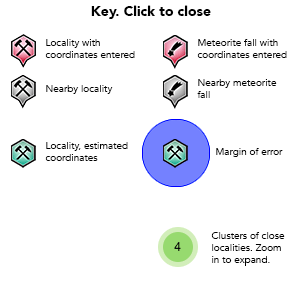Mount Padbury meteorite, Mount Padbury Station, Meekatharra Shire, Western Australia, Australia

| Latitude & Longitude (WGS84): | 25° 40' South , 118° 6' East |
|---|---|
| Latitude & Longitude (decimal): | -25.66667,118.10000 |
| GeoHash: | G#: qe7vzrtbc |
| Locality type: | Meteorite Fall Location |
| Meteorite Class: | Mesosiderite-A1 meteorite |
| Meteoritical Society Class: | Mesosiderite-A1 |
| Metbull: | View entry in Meteoritical Bulletin Database |
| Köppen climate type: | BWh : Hot deserts climate |
Stony-iron, Mesosiderite-A1
Find, 1964; 272 kg, largest mass 43 kg
Consisting of both large pieces and small fragments, the Mount Padbury meteorite was found during the mustering of sheep. It was soon recognized as a quite unusual mesosiderite. Volumetrically, the meteorite is dominated by various texturally and compositionally diverse silicates. Orthopyroxenes and lesser amounts of plagioclase are most prominent — both as individual crystals and as components of the fine grained matrix. Unusual olivine crystals enclosed by pyroxene-chromite rich coronas are also readily noted. Masswise, Fe-Ni metal (Ni~6%) accounts for slightly more than half of the meteorite mass (53 wt%). Much of the Fe-Ni metal is found as scattered, ganglion-like nodules which appear to have invaded the silicate regions. Significant amounts of troilite (~7 wt%) are also present. In addition to the usual metal and brecciated silicates, however, an unusual number of quite striking inclusions are found — most notable are the anorthositic, dunite, plagioclase-pyroxene ('eucritic'), and pyroxenite ('diogenite') inclusions. These inclusions are characterized by their mineralogy and, often, similarities to HED meteorite groups. Weathering is significant in places, but remarkably fresh regions can be found. Over the past few decades, these features and correlations — noted early by McCall (1966) — have been examined and amplified in great detail. And, of course, observations of additional silicates, opaques, and other phases have been reported.
Ar-Ar dating suggests that Mount Padbury's original parent body (OPB) — or, perhaps, an important fragment of the OPB — was involved in one or more important collisions between 3.5 and 4.0 billion years ago. Similar chronologies have also been reported for other mesosiderites. In the past decade, close and suggestive similarities in oxygen isotope ratios of mesosiderites with the (mostly) Vesta-derived HED meteorites have been confirmed. On the other hand, these same high resolution studies have also clearly separated the mesosiderites from the various pallasite groups and appear to rule out common OPB for the two major stony-iron groups.
Mt. Padbury is one of 7 meteorites classified as Mesosiderite-A1 (high plagioclase abundance; unmetamorphosed, fine-grained matrix). The main mass is at the Western Australian Museum in Perth. A 7 kg portion at the U.S. National Museum in Washington, DC is the most massive of several pieces that have been distributed elsewhere.
Mineral List
20 valid minerals.
Meteorite/Rock Types Recorded
Select Rock List Type
Alphabetical List Tree DiagramRegional Geology
This geological map and associated information on rock units at or nearby to the coordinates given for this locality is based on relatively small scale geological maps provided by various national Geological Surveys. This does not necessarily represent the complete geology at this locality but it gives a background for the region in which it is found.
Click on geological units on the map for more information. Click here to view full-screen map on Macrostrat.org
| Quaternary 0 - 2.588 Ma ID: 921776 | colluvium 38491 Age: Pleistocene (0 - 2.588 Ma) Description: Colluvium and/or residual deposits, sheetwash, talus, scree; boulder, gravel, sand; may include minor alluvial or sand plain deposits, local calcrete and reworked laterite Comments: regolith; synthesis of multiple published descriptions Lithology: Regolith Reference: Raymond, O.L., Liu, S., Gallagher, R., Zhang, W., Highet, L.M. Surface Geology of Australia 1:1 million scale dataset 2012 edition. Commonwealth of Australia (Geoscience Australia). [5] |
| Paleoproterozoic 1600 - 2500 Ma ID: 3184366 | Paleoproterozoic sedimentary and volcanic rocks Age: Proterozoic (1600 - 2500 Ma) Stratigraphic Name: Glengarry Group Comments: Naberru Basin Lithology: Mafic volcanic rocks; basalt; greywacke,iron formation,shale,sandstone,conglomerate Reference: Chorlton, L.B. Generalized geology of the world: bedrock domains and major faults in GIS format: a small-scale world geology map with an extended geological attribute database. doi: 10.4095/223767. Geological Survey of Canada, Open File 5529. [154] |
Data and map coding provided by Macrostrat.org, used under Creative Commons Attribution 4.0 License
References
External Links
http://www.lpi.usra.edu/meteor/metbull.php?sea=Mount+Padbury&sfor=names&ants=&falls=&valids=&stype=contains&lrec=50&map=ge&browse=&country=All&srt=name&categ=All&mblist=All&rect=&phot=&snew=0&pnt=Normal%20table&code=16785
http://www.encyclopedia-of-meteorites.com/test/mount_padbury_sv.jpg
http://www.minersoc.org/pages/Archive-MM/Volume_36/36-276-1029.pdf - McCall et al., 1966.
http://articles.adsabs.harvard.edu/cgi-bin/nph-iarticle_query?bibcode=1978LPSC....9.1053F&db_key=AST&page_ind=25&plate_select=NO&data_type=GIF&type=SCREEN_GIF&classic=YES — Floran Review (1978)
http://articles.adsabs.harvard.edu/full/1990AMR.....3...99I



